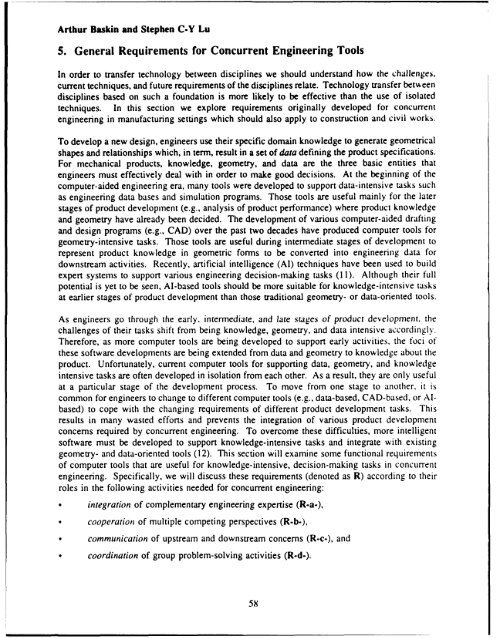Challenges and Opportunities for Innovation in the Public Works ...
Challenges and Opportunities for Innovation in the Public Works ...
Challenges and Opportunities for Innovation in the Public Works ...
You also want an ePaper? Increase the reach of your titles
YUMPU automatically turns print PDFs into web optimized ePapers that Google loves.
Arthur Bask<strong>in</strong> <strong>and</strong> Stephen C-Y Lu<br />
5. General Requirements <strong>for</strong> Concurrent Eng<strong>in</strong>eer<strong>in</strong>g Tools<br />
In order to transfer technology between discipl<strong>in</strong>es we should underst<strong>and</strong> how <strong>the</strong> challenges.<br />
current techniques, <strong>and</strong> future requirements of <strong>the</strong> discipl<strong>in</strong>es relate. Technology transfer bet%,een<br />
discipl<strong>in</strong>es based on such a foundation is more likely to be effective than <strong>the</strong> use of isolated<br />
techniques. In this section we explore requirements orig<strong>in</strong>ally developed <strong>for</strong> concurrent<br />
eng<strong>in</strong>eer<strong>in</strong>g <strong>in</strong> manufactur<strong>in</strong>g sett<strong>in</strong>gs which should also apply to construction <strong>and</strong> civil works.<br />
To develop a new design, eng<strong>in</strong>eers use <strong>the</strong>ir specific doma<strong>in</strong> knowledge to generate geometrical<br />
shapes <strong>and</strong> relationships which, <strong>in</strong> term, result <strong>in</strong> a set of data def<strong>in</strong><strong>in</strong>g <strong>the</strong> product specifications.<br />
For mechanical products, knowledge, geometry, <strong>and</strong> data are <strong>the</strong> three basic entities that<br />
eng<strong>in</strong>eers must effectively deal with <strong>in</strong> order to make good decisions. At <strong>the</strong> beg<strong>in</strong>n<strong>in</strong>g of <strong>the</strong><br />
computer-aided eng<strong>in</strong>eer<strong>in</strong>g era, many tools were developed to support data-<strong>in</strong>tensive tasks such<br />
as eng<strong>in</strong>eer<strong>in</strong>g data bases <strong>and</strong> simulation programs. Those tools are useful ma<strong>in</strong>ly <strong>for</strong> <strong>the</strong> later<br />
stages of product development (e.g., analysis of product per<strong>for</strong>mance) where product knowledge<br />
<strong>and</strong> geometry have already been decided. The development of various computer-aided draft<strong>in</strong>g<br />
<strong>and</strong> design programs (e.g., CAD) over <strong>the</strong> past two decades have produced computer tools <strong>for</strong><br />
geometry-<strong>in</strong>tensive tasks. Those tools are useful dur<strong>in</strong>g <strong>in</strong>termediate stages of development to<br />
represent product knowledge <strong>in</strong> geometric <strong>for</strong>ms to be converted <strong>in</strong>to eng<strong>in</strong>eer<strong>in</strong>g data <strong>for</strong><br />
downstream activities. Recently, artificial <strong>in</strong>telligence (Al) techniques have been used to build<br />
expert systems to support various eng<strong>in</strong>eer<strong>in</strong>g decision-mak<strong>in</strong>g tasks (11). Although <strong>the</strong>ir full<br />
potential is yet to be seen, Al-based tools should be more suitable <strong>for</strong> knowledge-<strong>in</strong>tensive tasks<br />
at earlier stages of product development than those traditional geometry- or data-oriented tools.<br />
As eng<strong>in</strong>eers go through <strong>the</strong> early, <strong>in</strong>termediate, <strong>and</strong> late stages of product development, <strong>the</strong><br />
challenges of <strong>the</strong>ir tasks shift from be<strong>in</strong>g knowledge, geometry, <strong>and</strong> data <strong>in</strong>tensive accord<strong>in</strong>gly.<br />
There<strong>for</strong>e, as more computer tools are be<strong>in</strong>g developed to support early activities, <strong>the</strong> foci of<br />
<strong>the</strong>se software developments are be<strong>in</strong>g extended from data <strong>and</strong> geometry to knowledge about <strong>the</strong><br />
product. Un<strong>for</strong>tunately, current computer tools <strong>for</strong> support<strong>in</strong>g data, geometry, <strong>and</strong> knowledge<br />
<strong>in</strong>tensive tasks are often developed <strong>in</strong> isolation from each o<strong>the</strong>r. As a result, <strong>the</strong>y are only useful<br />
at a particular stage of <strong>the</strong> development process. To move from one stage to ano<strong>the</strong>r, it is<br />
common <strong>for</strong> eng<strong>in</strong>eers to change to different computer tools (e.g., data-based, CAD-based, or Albased)<br />
to cope with <strong>the</strong> chang<strong>in</strong>g requirements of different product development tasks. This<br />
results <strong>in</strong> many wasted ef<strong>for</strong>ts <strong>and</strong> prevents <strong>the</strong> <strong>in</strong>tegration of various product development<br />
concerns required by concurrent eng<strong>in</strong>eer<strong>in</strong>g. To overcome <strong>the</strong>se difficulties, more <strong>in</strong>telligent<br />
software must be developed to support knowledge-<strong>in</strong>tensive tasks <strong>and</strong> <strong>in</strong>tegrate with exist<strong>in</strong>g<br />
geometry- <strong>and</strong> data-oriented tools (12). This section will exam<strong>in</strong>e some functional requirements<br />
of computer tools that are useful <strong>for</strong> knowledge-<strong>in</strong>tensive, decision-mak<strong>in</strong>g tasks <strong>in</strong> concurrent<br />
eng<strong>in</strong>eer<strong>in</strong>g. Specifically, we will discuss <strong>the</strong>se requirements (denoted as R) accord<strong>in</strong>g to <strong>the</strong>ir<br />
roles <strong>in</strong> <strong>the</strong> follow<strong>in</strong>g activities needed <strong>for</strong> concurrent eng<strong>in</strong>eer<strong>in</strong>g:<br />
<strong>in</strong>tegration of complementary eng<strong>in</strong>eer<strong>in</strong>g expertise (R-a-),<br />
cooperation of multiple compet<strong>in</strong>g perspectives (R-b-),<br />
communication of upstream <strong>and</strong> downstream concerns (R-c-), <strong>and</strong><br />
coord<strong>in</strong>ation of group problem-solv<strong>in</strong>g activities (R-d-).<br />
5X







